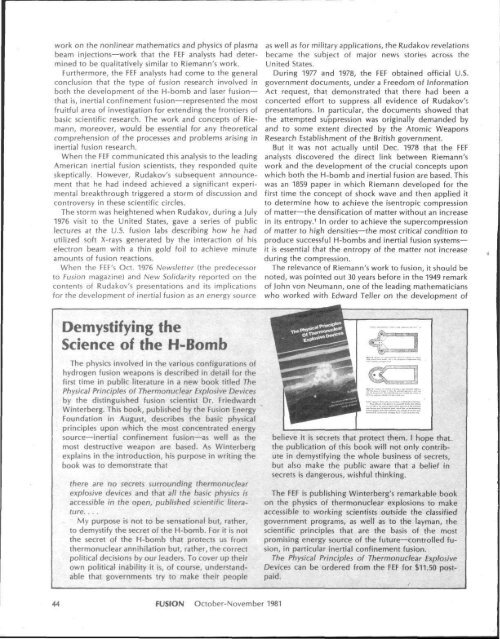Riemann's Contribution to Flight and Laser Fusion
Riemann's Contribution to Flight and Laser Fusion
Riemann's Contribution to Flight and Laser Fusion
- No tags were found...
Create successful ePaper yourself
Turn your PDF publications into a flip-book with our unique Google optimized e-Paper software.
work on the nonlinear mathematics <strong>and</strong> physics of plasmabeam injections—work that the FEF analysts had determined<strong>to</strong> be qualitatively similar <strong>to</strong> <strong>Riemann's</strong> work.Furthermore, the FEF analysts had come <strong>to</strong> the generalconclusion that the type of fusion research involved inboth the development of the H-bomb <strong>and</strong> laser fusion—that is, inertial confinement fusion—represented the mostfruitful area of investigation for extending the frontiers ofbasic scientific research. The work <strong>and</strong> concepts of Riemann,moreover, would be essential for any theoreticalcomprehension of the processes <strong>and</strong> problems arising ininertial fusion research.When the FEF communicated this analysis <strong>to</strong> the leadingAmerican inertial fusion scientists, they responded quiteskeptically. However, Rudakov's subsequent announcementthat he had indeed achieved a significant experimentalbreakthrough triggered a s<strong>to</strong>rm of discussion <strong>and</strong>controversy in these scientific circles.The s<strong>to</strong>rm was heightened when Rudakov, during a July1976 visit <strong>to</strong> the United States, gave a series of publiclectures at the U.S. fusion labs describing how he hadutilized soft X-rays generated by the interaction of hiselectron beam with a thin gold foil <strong>to</strong> achieve minuteamounts of fusion reactions.When the FEF's Oct. 1976 Newsletter (the predecessor<strong>to</strong> <strong>Fusion</strong> magazine) <strong>and</strong> New Solidarity reported on thecontents of Rudakov's presentations <strong>and</strong> its implicationsfor the development of inertial fusion as an energy sourceas well as for military applications, the Rudakov revelationsbecame the subject of major news s<strong>to</strong>ries across theUnited States.During 1977 <strong>and</strong> 1978, the FEF obtained official U.S.government documents, under a Freedom of InformationAct request, that demonstrated that there had been aconcerted effort <strong>to</strong> suppress all evidence of Rudakov'spresentations. In particular, the documents showed thatthe attempted suppression was originally dem<strong>and</strong>ed by<strong>and</strong> <strong>to</strong> some extent directed by the A<strong>to</strong>mic WeaponsResearch Establishment of the British government.But it was not actually until Dec. 1978 that the FEFanalysts discovered the direct link between <strong>Riemann's</strong>work <strong>and</strong> the development of the crucial concepts uponwhich both the H-bomb <strong>and</strong> inertial fusion are based. Thiswas an 1859 paper in which Riemann developed for thefirst time the concept of shock wave <strong>and</strong> then applied it<strong>to</strong> determine how <strong>to</strong> achieve the isentropic compressionof matter—the densification of matter without an increasein its entropy. 1 In order <strong>to</strong> achieve the supercompressionof matter <strong>to</strong> high densities—the most critical condition <strong>to</strong>produce successful H-bombs <strong>and</strong> inertial fusion systems—it is essential that the entropy of the matter not increaseduring the compression.The relevance of <strong>Riemann's</strong> work <strong>to</strong> fusion, it should benoted, was pointed out 30 years before in the 1949 remarkof John von Neumann, one of the leading mathematicianswho worked with Edward Teller on the development ofDemystifying theScience of the H-BombThe physics involved in the various configurations ofhydrogen fusion weapons is described in detail for thefirst time in public literature in a new book titled ThePhysical Principles of Thermonuclear Explosive Devicesby the distinguished fusion scientist Dr. FriedwardtWinterberg. This book, published by the <strong>Fusion</strong> EnergyFoundation in August, describes the basic physicalprinciples upon which the most concentrated energysource—inertial confinement fusion—as well as themost destructive weapon are based. As Winterbergexplains in the introduction, his purpose in writing thebook was <strong>to</strong> demonstrate thatthere are no secrets surrounding thermonuclearexplosive devices <strong>and</strong> that all the basic physics isaccessible in the open, published scientific literature.. . .My purpose is not <strong>to</strong> be sensational but, rather,<strong>to</strong> demystify the secret of the H-bomb. For it is notthe secret of the H-bomb that protects us fromthermonuclear annihilation but, rather, the correctpolitical decisions by our leaders. To cover up theirown political inability it is, of course, underst<strong>and</strong>ablethat governments try <strong>to</strong> make their peoplebelieve it is secrets that protect them. I hope thauthe publication of this book will not only contributein demystifying the whole business of secrets,but also make the public aware that a belief insecrets is dangerous, wishful thinking.The FEF is publishing Winterberg's remarkable bookon the physics of thermonuclear explosions <strong>to</strong> makeaccessible <strong>to</strong> working scientists outside the classifiedgovernment programs, as well as <strong>to</strong> the layman, thescientific principles that are the basis of the mostpromising energy source of the future—controlled fusion,in particular inertial confinement fusion.The Physical Principles of Thermonuclear ExplosiveDevices can be ordered from the FEF for $11.50 postpaid.44 FUSION Oc<strong>to</strong>ber-Novembe1981
















